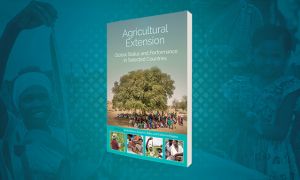The project Reaching Smallholder Women with Information Services and Resilience Strategies to Respond to Climate Change aimed to increase the climate resilience of poor women and men farmers in Africa south of the Sahara and South Asia — especiall
Search
Information and communications technology (ICT) in low- and middle-income countries has changed significantly over the past seven decades, starting with radio and newspapers and transforming almost daily with the rise of smartphones and mobile Int
農業の変革と発展は、開発途上国の10億人以上の小規模農家をはじめ農村に 暮らす人々の生活にとって非常に重要である農業改良普及は、こうした変革 において重要な役割を果たし、アドバイス、情報提供、イノベーション、関係の仲介・促進、リスクや災害への対応などにより農民を支援することがで きる。本書は、農業改良普及の世界的な概要を示し、国および地域レベルの 改良普及システムを評価・比較し、以下の分野における改良普及アプローチ のパフォーマンスを検証している。
International extension networks provide vital services to stakeholders using a variety of organizational structures.
Development and validation of the international extension network advocacy capacity scale
Extension is sometimes viewed globally as less important than academic research and innovation, even though these networks are crucial to agricultural development.
Agricultural extension provides the critical connection from agricultural innovation and discovery to durable improvements at scale, as farmers and other actors in the rural economy learn, adapt, and innovate with new technologies and practices.
Effective organizational functioning capacity needs of rural advisory service networks: A Delphi study
This study expands on previous research within an international extension context with a particular focus on identifying the capacities associated with effective organizational functioning.
CGIAR’s digital extension services bridge the gap between the development and the adoption of new climate change adaptation strategies.
Organizational innovation in times of crises: The case of extension and advisory services
Since it formally began, extension institutions have been innovating in response to the changing environment. Past crises have induced organizational innovation in limited ways.
As seen in Chapter 2, extension has evolved over the decades in various ways: in terms of its governance structure, in terms of who provides extension, in terms of capacity (staffing) and management, and in terms of advisory methods.
How can extension services best help small farmers meet today’s challenges? This global study points to ways to improve outcomes, enhance financial sustainability, and achieve greater scale.
This chapter is a landscape view of extension globally. It compares the recent status to the situation several decades ago, when earlier global assessments were conducted.
Conclusions and policy implications
The two objectives of this book are to assess extension and advisory services in a cross-country comparative context in the following ways: 1.
Introduction and motivation
Agricultural development is critical to the livelihoods of more than a billion small-scale farmers and other rural populations in developing countries.
Agricultural transformation and development are critical to the livelihoods of more than a billion small-scale farmers and other rural people in developing countries.
The 2016 Global Hunger Index Africa Edition is produced by the International Food Policy Research Institute (IFPRI), Concern Worldwide, and Welthungerhilfe in conjunction with NEPAD.
Global, regional, and national trends
The 2016 Global Hunger Index (GHI) demonstrates substantial progress in terms of hunger reduction for the developing world.
The 2016 Global Hunger Index (GHI) report—the eleventh in an annual series—presents a multidimensional measure of national, regional, and global hunger.
The concept of the global hunger index
The Global Hunger Index (GHI) is a tool designed to comprehensively measure and track hunger at the global, regional, and country levels.

